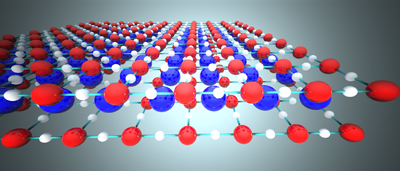Intrinsic superconductor behavior revealed
By Anne Ju

When it comes to high-temperature superconductors, a class of materials called cuprates is king, and it is science's ongoing quest to determine their exact physical subtleties. Cornell physicists and materials scientists have now verified that cuprates respond differently when adding electrons versus removing them, resolving a central issue about the compounds' most fundamental properties.
The multidisciplinary study was a collaboration led by graduate student John Harter; visiting professor Luigi Maritato of the University of Salerno, Italy; and senior authors Darrell Schlom, the Herbert Fisk Johnson Professor of Industrial Chemistry, and Kyle Shen, assistant professor of physics, both members of the Kavli Institute at Cornell for Nanoscale Science, and published Dec. 27 in Physical Review Letters.
The study describes the behavior of a strontium-lanthanum copper oxide cuprate superconductor when chemically "doped" with electrons, meaning more electrons are introduced into their two-dimensional copper-oxygen sheets, where superconductivity is known to reside.
When cooled to about 100 Kelvin (-280 Fahrenheit), the electrons in these sheets undergo a phase transition and become superconducting, which means electrons can flow freely through them without resistance. The cuprates are the highest-temperature class of superconductors known -- "high temperature" by physicists' standards, anyway.
Shen and colleagues chose to explore the strontium-lanthanum cuprates, which physicists nickname the "infinite layer" compound, to observe their transition into and out of a magnetic state called antiferromagnetism by doping electrons into the system.
They confirmed, using photoelectron spectroscopy to map the motion of electrons, that the shift from antiferromagnetism was similar to the shift observed in the only other class of electron-doped cuprate superconductor, called RCCO -- confirming for the first time that these behaviors are intrinsic to all electron-doped cuprates, but behave quite differently from their so-called hole-doped cousins.
It was an important discovery, Shen said, because the electron-doped cuprate superconductors are poorly understood compared with hole-doped cuprates: their behavior altered by the removal of electrons from the lattice. Many theories describing high-temperature superconductivity intrinsically assume that the cuprates should respond the same way when doping with electrons or holes -- an assumption that now needs to be revisited, Shen said.
Schlom's thin films of the infinite layer cuprates allowed for this precise electron mapping. It had previously been nearly impossible to study this compound because it is usually found in a powdery form unsuitable for measurements.
A combined technique of molecular-beam epitaxy to make the films, and the films' immediate transfer to spectroscopic analysis, was made possible by an integrated molecular beam epitaxy system with an angle-resolved photoemission spectrometer. This technique could pave the way for making brand-new materials with superconducting properties, Shen said. The thin film fabrication and measurements were carried out by Harter and Maritato.
The research was supported by the Air Force Office of Scientific Research, the National Science Foundation via the Cornell Center for Materials Research and the Army Research Office.
Media Contact
Get Cornell news delivered right to your inbox.
Subscribe